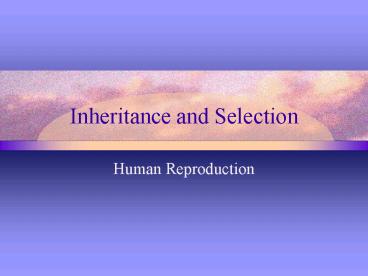Inheritance and Selection - PowerPoint PPT Presentation
1 / 31
Title:
Inheritance and Selection
Description:
The embryo develops into a foetus attached to the placenta by the umbilical cord. ... and a vein run through the umbilical cord and connect the foetus' blood ... – PowerPoint PPT presentation
Number of Views:86
Avg rating:3.0/5.0
Title: Inheritance and Selection
1
Inheritance and Selection
- Human Reproduction
2
Lesson Aims
- To ensure all students know the structure and
function of the human sex organs. - To understand the process of human fertilisation
- To be aware of the sequence of events in the
development of a human foetus - To understand the structure and function of the
placenta.
3
Human sex organs
- Answer all questions on the sheet you are given.
- Stick the sheet in your exercise books.
4
Fertilsation
5
Fertilisation
- Ejaculation produces about 5 ml of semen which
contains 450 million sperm.
6
Fertilisation
- Although thousands of sperm may reach an egg,
only one enters it.
7
Fertilisation
- To be successful the sperm must meet the egg in
the Fallopian tube.
8
Fertilisation
- The tail of the sperm remains outside as the head
travels through the egg cytoplasm to the nucleus.
9
Fertilisation
- Fertilisation occurs when the sperm nucleus fuses
with the egg nucleus to form a zygote. This is
the moment of conception.
10
Diary of human development
- Week 0
- Egg is fertilised in the fallopian tube.
11
Diary of human development
- Week 1
- Embryo becomes attached to the lining of the
uterus (womb).
12
Diary of human development
- Week 2
- Foetus eyes begin to develop. Its legs and arms
are tiny bumps.
13
Diary of human development
- Week 6
- Foetus begins to look like a human. Ears, hands
and feet begin to grow. Heart begins to beat.
14
(No Transcript)
15
Diary of human development
- Week 10
- Foetus fingers and toes grow. It can move its
arms and legs a little it can swallow and frown.
16
Diary of human development
- Week 14
- It is possible to determine the foetuss sex.
17
Diary of human development
- Week 18
- Foetus has hair, eyebrows. Doctors can hear the
heartbeat. Mother begins to feel its kicks.
18
Diary of human development
- Week 26
- Foetus opens its eyes.
19
Diary of human development
- Week 30
- If born now, the baby could live with special
care.
20
Diary of human development
- Week 34
- Baby has grown a lot of fat in the last 4 weeks,
to keep it warm when it is born.
21
Diary of human development
- Week 38
- Baby is born.
22
The Placenta
- Stick the diagram of the placenta in your books
23
The placenta
- The zygote divides as it passes to the uterus and
becomes and embryo. - The embryo implants in the thick lining of the
uterus.
24
The placenta
- Finger like extensions called villi project from
the embryo into the lining of the uterus
eventually forming the placenta.
25
The placenta
- The embryo develops into a foetus attached to the
placenta by the umbilical cord.
26
The placenta
- An artery and a vein run through the umbilical
cord and connect the foetus blood system to the
placenta.
27
The placenta
- The foetus blood system IS NOT DIRECTLY CONNECTED
to the blood system of the mother.
28
The placenta
- The exchange of oxygen, food and wastes between
the mother and foetus depends on diffusion across
the thin wall of the placenta.
29
The placenta
- Harmful substances such as nicotine, alcohol,
drugs and virus can also pass across the placenta
from the mother to the foetus.
30
The placenta
- The _______ grows from the _______
- The foetus is connected to the placenta by the
__________ _________ . - In the cord there is an _______ and a _____
coming from the foetus. - The placenta brings the _______ of the foetus
very ________ to the blood of the _______ but the
different ___________ do not mix.
31
The placenta
- ___ and ____ pass from the mothers ______ into
the foetus. _____ , ______ and other _______
substances pass from the _____ into the _______
blood. - Harmful substances such as _______, ______,
________ products and _____ can also pass into
the foetus through the _________ from the mother.





![DOWNLOAD [PDF] Eragon: Inheritance, Book 1 PowerPoint PPT Presentation](https://s3.amazonaws.com/images.powershow.com/10129452.th0.jpg?_=20240911019)

























